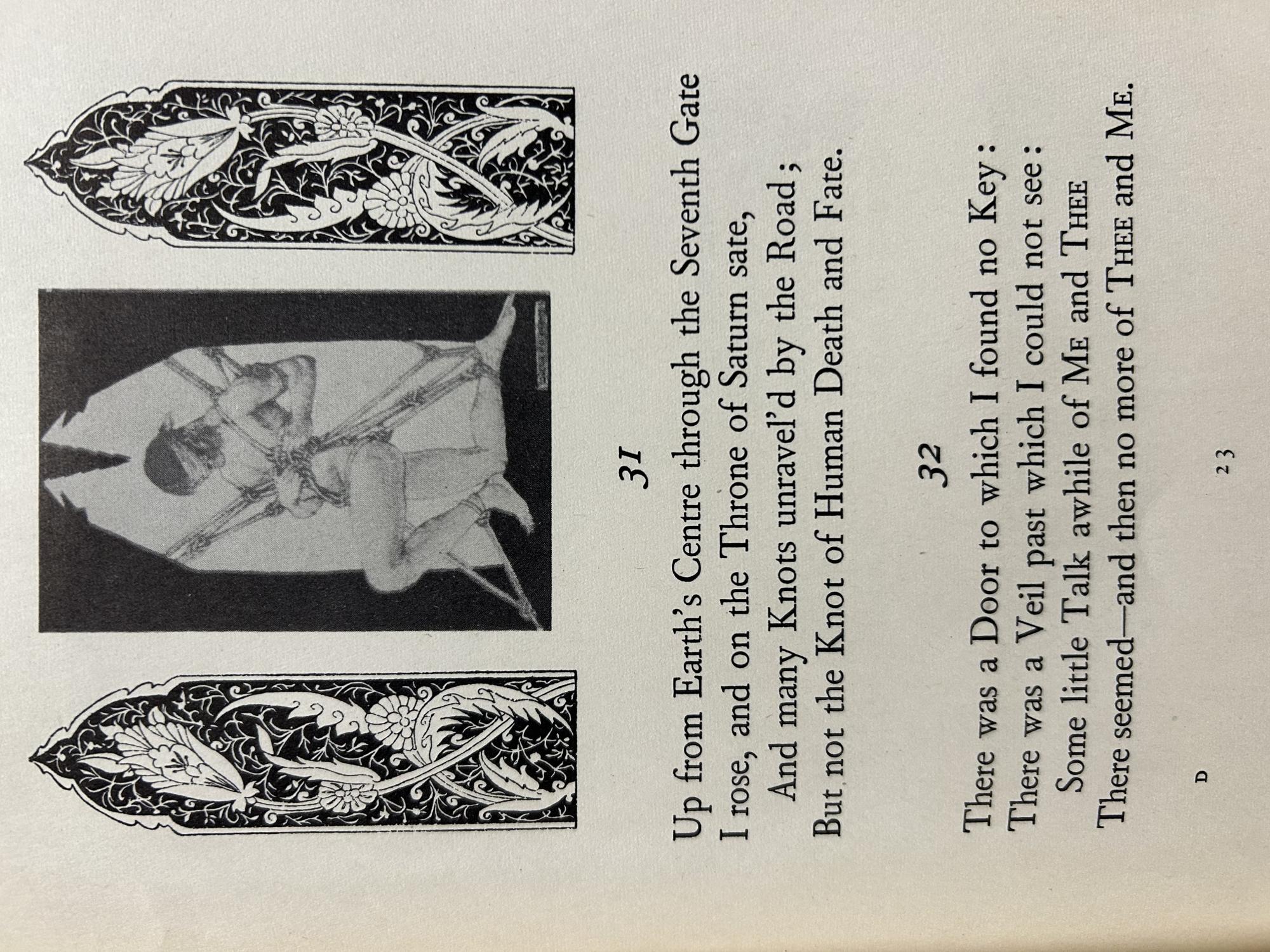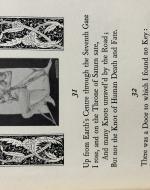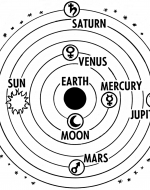Created by Katelyn Maloney on Fri, 05/12/2023 - 19:10
Description:
One of the most interesting examples of Pogány's mastery in illustration can be seen in stanzas 31and 32, although we shall focus on 31 alone for the sake of brevity. Following the theme of the rest of the Rubáiyát , this stanza is a quatrain that follows the rhyme scheme of AABA, linked together with the end rhymes 'gate, sate, and fate.' It breaks from the theme of indulgence, but is a great example Khayyám's repeated philosophy of a form of existentialism. There are two forms of imagery that can be assumed to exhibit a certain meaning, with the Road relating to Life's journey as the 'Road of Life,' and the Knots representing some sort of mental hurdle. There is more room for discussion in what exactly the Knot is meant to be, with the strongest connotations seeming to use it as either a mystery of Life, or an obstacle of it.
In this short text, Khayyám bears his thoughts through the imagery he chooses to represent life here, in the forms of the Road and the Knot. Although it is harder to guess if this was Khayyám's intention or a mistranslation by Fitzgerald, but the perspective of the narrating voice plays a big part in how the reader is meant to perceive this theme. The reader is not unraveling the Knots themselves, rather they are watching as the Road itself undoes these mysteries or obstacles, sitting back and allowing the course of events to flow naturally. However, in this Khayyám admits that there is one Knot that continues to elude resolution, the Knot of Human Death and Fate. If the Road is meant to represent Life's Journey, than "Human Death (Khayyám, 31)" stands to reason being the one puzzle the road didn't solve. It is in watching this all unfold does the narrator come to ponder his position in it all.
The part of this stanza that is most open to discussion is within the first two lines, with references to the "Seventh Gate" and "Throne of Saturn." There are a couple of translations that could fit this narrative. One option would be an answer that includes both turns of phrase, as well as alluding to Khayyam's passion for astronomy. In historical Islamic astronomy, Saturn would have been known as the seventh planet in the geocentric model (Wikipedia as a placeholder source), as seen illustrated in other models. If this is the case, then the Throne of Saturn would have been the Throne of the Seventh Planet, hence the Seventh Gate. There are other examples of Seventh Gates, but none have the same attachment to Khayyám's life as this one. By using the Throne of Saturn, it creates an aura of distance, pushing both the narrator and the reader to the audience, watching from a detached perspective. It gives plenty more room for contemplation, accentuating the theme of the stanza.
This sense of distance between the actual event and the narrator is well illustrated by Pogány's hands. The figure depicted finds themselves wrapped up in these knots, held in place from both up and down. The sense of futility and distance is enhanced by the subjects inability to physically move, as well as being an explicit reference to the Knots mentioned in the stanza. The largest knot (or cluster of knots) is in the center of his chest, close to where the heart is, drawing an emotional connection. Rather than unraveling this knot, the figure is simply pulling at it. He is depicted as lost and helpless, an easy assumption to make from the reasoning of the stanza. Pogány chose not to depict the Throne of Saturn at all, likely from the true abstractness of the concept.
Khayyam, Omar. Rubáiyát of Omar Khayyam. Translated by Edward FitzGerald, illustrated by Willy Pogány, New York: Thomas Y. Crowell Company, 1935(?).
"Circle 7, cantos 12-17." Dante's Inferno, University of Texas, danteworlds.laits.utexas.edu/circle7.html. Accessed 15 May 2023. A description and full copy of Dante's Inferno Cantos 12-17.
Platonic Geocentric Model. This is the geocentric model of the Solar System with the Earth at the centre. Wikipedia, en.wikipedia.org/wiki/Historical_models_of_the_Solar_System#/media/File:Ptolemaic_system_2_(PSF).png.
Copyright:
Associated Place(s)
Part of Group:
Featured in Exhibit:
Artist:
- Willy Pogany



